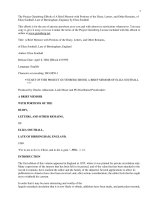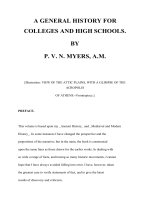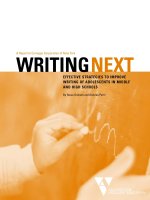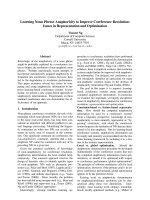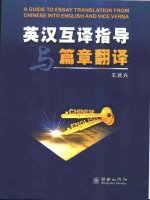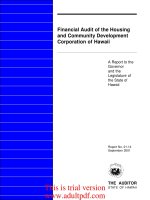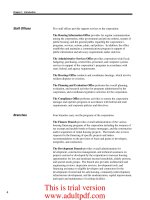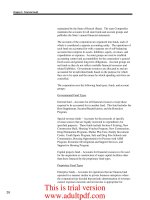A Report to Carnegie Corporation of New York WRITINGNEXT EFFECTIVE STRATEGIES TO IMPROVE WRITING OF ADOLESCENTS IN MIDDLE AND HIGH SCHOOLS potx
Bạn đang xem bản rút gọn của tài liệu. Xem và tải ngay bản đầy đủ của tài liệu tại đây (373.09 KB, 77 trang )
WRITINGNEXT
EFFECTIVE STRATEGIES TO IMPROVE
WRITING OF ADOLESCENTS IN MIDDLE
AND HIGH SCHOOLS
By Steve Graham and Dolores Perin
A Report to Carnegie Corporation of New York
No part of this publication may be reproduced or transmitted in any form or by any means, electronic
or mechanical, including photocopy, or any information storage and retrieval system, without permission
fr
om Car
ne
g
ie Corporation of New York.
A full-text PDF of this document is a
v
ailab
le for fr
ee download
fr
om www
.all4ed.org and www
.car
neg
ie.org/literacy.Additional print copies of this report may be ordered from
the Alliance for Excellent Education at 1201 Connecticut Avenue, NW, Suite 901,Washington, DC 20036,
(202) 828-0828.
Permission for reproducing excerpts from this report should be directed to: Permissions Department, Carnegie
Corporation of Ne
w
York, 437 Madison Avenue, New York, NY 10022.
Suggested citation: Graham, S., & Perin, D. (2007). Writing next: Effective strategies to improve writing of adolescents
in middle and high schools – A report to Carnegie Corporation of New York. Washington, DC: Alliance for Excellent
Education.
© 2007 Carnegie Corporation of Ne
w York. All rights reserved.
Car
negie Corporation’s
Ad
vancing Literacy
pr
ogram is dedicated to the issues of adolescent literacy and
the research, policy, and practice that focus on the reading and writing competencies of middle and high
school students. Advancing Literacy reports and other publications are designed to encourage local and national
discussion, explore promising ideas, and incubate models of practice, but do not necessarily represent the
recommendations of the Corporation. For more information, visit www.carnegie.org/literacy.
Pub
lished by the Alliance for Excellent Education.
WRITINGNEXT
EFFECTIVE STRATEGIES TO IMPROVE
WRITING OF ADOLESCENTS IN MIDDLE
AND HIGH SCHOOLS
By Steve Graham and Dolores Perin
A Report to Carnegie Corporation of New York
A Report to Carnegie Corporation of New York
ii
About Carnegie Corporation of New York
Carnegie Corporation of New York was created by Andrew Carnegie in 1911 to promote “the
advancement and diffusion of knowledge and understanding.”As a grant-making foundation, the
Corporation seeks to carry out Carnegie’s vision of philanthropy, which he said should aim “to do
real and permanent good in the world.” The Corporation’s capital fund, originally donated at a value
of about $135 million, had a market value of $2.2 billion on September 30, 2005.The Corporation
awards grants totaling approximately $80 million a year in the areas of education, international peace
and security, international development, and strengthening U.S. democracy. For more information,
visit www.carnegie.org.
About the Alliance for Excellent Education
Based in Washington, D.C., the Alliance for Excellent Education is a national policy and advocacy
organization that works to ensure that all children graduate from high school prepared for college
and work and to be contributing members of society. It focuses on the needs of the six million
secondary school students (those in the lowest achievement quartile) who are most likely to leave
school without a diploma or to graduate unprepared for a productive future.
The Alliance’s audience includes parents, educators, the federal, state, and local policy communities,
education organizations, business leaders, the media, and a concerned public.To inform the national
debate about education policies and options, the Alliance produces reports and other materials, makes
presentations at meetings and conferences, briefs policymakers and the press, and provides timely
information to a wide audience via its biweekly newsletter and regularly updated website,
www.all4ed.org.
iii
The Authors
Dr. Steve Graham is the Currey Ingram Professor of Special Education and Literacy, a chair he shares
with Karen R. Harris, at Vanderbilt University’s Peabody College of Education. His research interests
include learning disabilities, writing instruction and writing development, and the development of
self-regulation. Graham’s research has focused primarily on identifying the factors that contribute to
the development of writing difficulties; the development and validation of effective procedures for
teaching planning, revising, and the mechanics of writing to struggling writers; and the use of technol-
ogy to enhance writing performance and development. Graham is the editor of
Exceptional Children
and the former editor of Contemporary Educational Psychology. He is coauthor of the Handbook of Writing
Research, Handbook of Learning Disabilities,Writing Better,
and Making the Writing Process Work. He
received an EdD in special education from the University of Kansas. In 2001, Graham was elected a
fellow of the International Academy for Research in Learning Disabilities. He is the recipient of career
research awards from the Council for Exceptional Children and Special Education Research Interest
Group in the American Educational Research Association.
Dr. Dolores Perin is associate professor of psycholo
gy and education at Teachers College, Columbia
University. She directs the Reading Specialist MA Program, which prepares teachers to assess and
teach children and adolescents with reading and writing difficulties. Perin is also a senior research
associate at Teachers College’s Community College Research Center. Her research interests include
the education of academically underprepared students in secondary education, community colleges,
and adult literacy programs, and the preparation of teachers to incorporate literacy strategies in
content-area instruction in middle and high schools. She is principal investigator of studies entitled
“Enhancing Teacher Preparation for Adolescent Literacy through Interdisciplinary Learning
Communities” (Carnegie Corporation of New York) and “Postsecondary Content-Area Reading-
Writing Intervention: Development and Determination of Potential Efficacy” (U.S. Department of
Education Institute of Education Sciences).
Her work also includes studies of community college
de
velopmental education; the integration of academic and career education, funded by the Alfred P.
Sloan F
oundation; and state- and federally-funded projects in school-to-work transition, workplace
literacy
, and adult learning disabilities. Perin received a PhD in psychology from the University of
Sussex in England and is a Ne
w York State-licensed psychologist.
A Report to Carnegie Corporation of New York
iv
Acknowledgments
The authors would like to thank Andrés Henríquez, program officer at Carnegie Corporation of New
York, and Cindy Sadler at the Alliance for Excellent Education, who offered helpful suggestions in the
conceptualization and reporting of this research.We wish to thank Joel Levin, Chris Schatschneider,
and Robert Bangert-Drowns for their advice and assistance. Regan Phillips and Beth Chase assisted
in the collection and organization of material for the study, and Paul Morphy served as a second coder
to establish reliability. A special thanks goes to Andrew Wilson and Gina Biancarosa, who took a
120-page document and worked and reworked it to make it suitable for a broad audience.They not
only made the document more readable but contributed important ideas regarding how this work
should be framed and presented. It was a pleasure to work with them.They are both consummate
professionals.The order of authorship is alphabetical.
Steve Graham
Dolor
es P
erin
Writing Next: Effective strategies to improve writing of adolescents in middle and high schools
v
CONTENTS
Foreword by Vartan Gregorian 1
Executive Summary 3
Introduction 7
Recommendations: 11 Key Elements of Effective Adolescent Writing Instruction
as Identified by Meta-analysis
11
Implementing the Elements 22
Accumulation of Research on Adolescent Writing Instruction 25
A Challenge 28
References 29
Appendix A: Meta-analysis Methodology 35
Appendix B:
Quasi-experimental and Experimental Studies
Suppor
ting the 11 Key Elements
43
A Report to Carnegie Corporation of New York
vi
Writing Next: Effective strategies to improve writing of adolescents in middle and high schools
1
FOREWORD
Around the world, from the cave paintings in Lascaux, France, which may be 25,000 years old, to the
images left behind by the lost Pueblo cultures of the American Southwest, to the ancient aboriginal
art of Australia, the most common pictograph found in rock paintings is the human hand. Coupled
with pictures of animals, with human forms, with a starry night sky or other images that today we can
only identify as abstract, we look at these men’s and women’s hands, along with smaller prints that
perhaps belong to childr
en, and cannot help but be deeply moved by the urge of our ancestors to
lea
ve some permanent imprint of themselves behind.
Clearly, the instinct for human beings to express their feelings, their thoughts, and their experiences
in some lasting form has been with us for a very long time.This urge eventually manifested itself in
the creation of the first alphabet, which many attribute to the Phoenicians.When people also began
to recognize the concept of time, their desire to express themselves became intertwined with the
sense of wanting to leave behind a legacy, a message about who they were, what they had done and
seen, and even what they believed in.Whether inscribed on rock, carved in cuneiform, painted in
hieroglyphics, or written with the aid of the alphabet, the instinct to write down everything from
mundane commercial transactions to routine daily occurrences to the most transcendent ideas—and
then to ha
v
e other
s read them, as well as to read what others have written—is not simply a way of
transfer
r
ing infor
mation fr
om one per
son to another, one generation to the next. It is a process of
lear
ning and hence
,
of education.
Ariel and Will Durant were right when they said,“Education is the transmission of civilization.”
Putting our current challenges into historical context, it is obvious that if today’s youngsters cannot
read with understanding, think about and analyze what they’ve read, and then write clearly and
effectively about what they’ve learned and what they think, then they may never be able to do justice
to their talents and their potential. (In that regard, the etymology of the word
education, which is to
draw out and draw forth—from oneself, for example—is certainly evocative.) Indeed, young people
who do not have the ability to transform thoughts, experiences, and ideas into written words are in
danger of losing touch with the joy of inquiry, the sense of intellectual curiosity, and the inestimable
satisfaction of acquiring wisdom that are the touchstones of humanity.What that means for all of us is
that the essential educative transmissions that have been passed along century after century, generation
after generation,
ar
e in danger of f
ading a
w
a
y
, or even falling silent.
A Report to Carnegie Corporation of New York
2
In a recent report, the National Commission on Writing also addresses this concern.They say, “If
students are to make knowledge their own, they must struggle with the details, wrestle with the facts,
and rework raw information and dimly understood concepts into language they can communicate to
someone else. In short, if students are to learn, they must write.”
It is in this connection that I am pleased to introduce
Writing Next. As the report warns, American
students today are not meeting even basic writing standards, and their teachers are often at a loss for
how to help them. In an age overwhelmed by information (we are told, for example, that all available
information doubles every two to three years), we should view this as a crisis, because the ability to
r
ead, comprehend, and write—in other words, to organize information into
knowledge—can be vie
wed
as tantamount to a survival skill.Why? Because in the decades ahead, Americans face yet another
challenge: how to keep our democracy and our society from being divided not only between rich
and poor, but also between those who ha
ve access to information and knowledge, and thus, to
power—the power of enlightenment,
the po
wer of self-improvement and self-assertion, the power to
achieve upw
ard mobility
, and the power over their own lives and their families’ ability to thrive and
succeed—and those who do not.
Such an uncrossable divide will have devastating consequences for the future of America.Those who
enrich themselves by learning to read with understanding and write with skill and clarity do so not
only for themselves and their families, but for our nation as well.They learn in order to preserve and
enhance the record of humanity, to be productive members of a larger community, to be good citizens
and good ancestors to those who will follow after them. In an age of globalization, when economies
sink or swim on their ability to mine and manage knowledge, as do both individual and national
security, we cannot afford to let this generation of ours or indeed, any other, fall behind the learning
curve. Let me bring us back to where we began: For all of us, the handprint must remain firmly and
clearly on the wall.
Vartan Gregorian
President, Carnegie Corporation of New York
Writing Next: Effective strategies to improve writing of adolescents in middle and high schools
3
EXECUTIVE SUMMARY
A Writing Proficiency Crisis
Writing well is not just an option for young people—it is a necessity. Along with reading comprehen-
sion, writing skill is a predictor of academic success and a basic requirement for participation in civic
life and in the global economy.Yet every year in the United States large numbers of adolescents gradu-
ate from high school unable to write at the basic levels required by colleges or employers. In addition,
every school day 7,000 young people drop out of high school (Alliance for Excellent Education,
2006), many of them because they lack the basic literacy skills to meet the growing demands of the
high school curriculum (Kamil, 2003; Snow & Biancarosa, 2003). Because the definition of
literacy
includes both reading and writing skills, poor writing proficiency should be recognized as an intrinsic
part of this national literacy crisis.
This report offers a number of specific teaching techniques that research suggests will help 4th- to
12th-grade students in our nation’s schools.The report focuses on all students, not just those who
display writing difficulties, although this latter group is deservedly the focus of much attention.The
premise of this report is that all students need to become proficient and flexible writers. In this report,
the term
low-achieving writers is used to refer to students whose writing skills are not adequate to meet
classroom demands. Some of these low-achieving writers have been identified as having learning
disabilities;
others are the “silent majority” who lack writing proficiency but do not receive additional
help
. As will be seen in this report, some studies investigate the effects of writing instruction on groups
of students acr
oss the full range of ability, from more effective to less effective writers, while others
focus specifically on indi
viduals with low writing proficiency.
Recent r
epor
ts b
y the National Commission on
Writing (2003, 2004, 2005) have helped to bring
the impor
tance of wr
iting pr
oficiency forw
ard into the public consciousness.These reports provide
a jumping-off point for thinking about ho
w to impr
o
v
e writing instruction for all young people,
with a special focus on str
uggling r
eader
s.
Reading Next (Biancar
osa & Sno
w
,
2004), commissioned by
Carneg
ie Cor
poration of New York, used up-to-date research to highlight a number of key elements
seen as essential to impr
o
ving r
eading instruction for adolescents (defined as grades 4–12).
Wr
iting
Next
sets out to pr
o
vide guidance for impr
oving writing instruction for adolescents, a topic that has
previously not r
eceived enough attention from researchers or educators.
A Report to Carnegie Corporation of New York
4
While Reading Next presented general methods and interventions that several of America’s most
respected adolescent literacy experts found to be useful for improving reading instruction,
Writing
Next
highlights specific teaching techniques that work in the classroom. It does so by summarizing
the results of a large-scale statistical review of research into the effects of specific types of writing
instruction on adolescents’ writing proficiency. Although several important reviews of research on
writing instruction exist (e.g., Langer & Applebee, 1987; Levy & Ransdell, 1996; MacArthur, Graham,
& Fitzgerald, 2006; Smagorinsky, 2006), the special strength of this report is its use of a powerful
statistical method known as meta-analysis.This technique allows researchers to determine the
consistency and strength of the effects of instructional practices on student writing quality and to
highlight those practices that hold the most promise.
The Recommendations
Eleven Elements of Effective Adolescent Writing Instruction
This report identifies 11 elements of current writing instruction found to be effective for helping
adolescent students learn to write well and to use writing as a tool for learning. It is important to note
that all of the elements are supported by rigorous research, but that even when used together, they do
not constitute a full writing curriculum.
1. Writing Strategies, which involves teaching students strategies for planning, revising, and
editing their compositions
2. Summarization, which involves explicitly and systematically teaching students how to
summarize texts
3. Collaborative Writing, which uses instructional arrangements in which adolescents work
together to plan, draft, revise, and edit their compositions
4. Specific Product Goals, which assigns students specific, reachable goals for the writing they
ar
e to complete
5.
W
or
d Pr
ocessing,
which uses computer
s and w
or
d pr
ocessors as instructional supports for
writing assignments
6. Sentence Combining, which involves teaching students to construct more complex,
sophisticated sentences
7. Prewriting, which engages students in activities designed to help them generate or organize
ideas for their composition
8. Inquir
y
Acti
vities
,
which engages students in analyzing immediate
,
concr
ete data to help
them develop ideas and content for a particular writing task
9. Process Writing Approach, which interweaves a number of writing instructional activities in
a w
orkshop en
vir
onment that str
esses extended wr
iting oppor
tunities, writing for authentic
audiences, personalized instruction, and cycles of writing
Writing Next: Effective strategies to improve writing of adolescents in middle and high schools
5
10. Study of Models, which provides students with opportunities to read, analyze, and emulate
models of good writing
11. Writing for Content Learning, which uses writing as a tool for learning content material
The
Writing Next elements do not constitute a full writing curriculum, any more than the Reading
Next
elements did for reading. However, all of the Writing Next instructional elements have shown
clear results for improving students’ writing.They can be combined in flexible ways to strengthen
adolescents’ literacy development.The authors hope that besides providing research-supported
information about effective writing instruction for classroom teachers, this report will stimulate
discussion and action at policy and research levels, leading to solid improvements in writing
instruction in grades 4 to 12 nationwide.
A Report to Carnegie Corporation of New York
6
Writing Next: Effective strategies to improve writing of adolescents in middle and high schools
7
INTRODUCTION
Although the nation has made progress recently in improving
the literacy achievement of its elementary school students,
adolescent literacy levels have remained stagnant (Lemke et al.,
2004; National Center for Education Statistics, 1999, 2006;
Olson, 2006). As a result, attention has begun to turn to the need
to impr
ove the literacy of adolescent students. One example of
this ne
w focus is the recently created Striving Readers Initiative,
a federal pr
ogram to help school districts meet the challenge of
improving adolescents’ literacy skills, for which the U.S. Congress
appropriated just over $29 million for the 2006–07 school year.
Several reports have drawn attention to the adolescent literacy
crisis (e.g., Kamil, 2003; American Diploma Project, 2004;
Carnevale, 2001; National Commission on Writing, 2004).
Among them,
Reading Next outlined elements of literacy
instruction with a strong track record of positive results among
adolescents (Biancar
osa & Sno
w
, 2004).While these reports
and other
s ha
v
e br
ought m
uch-needed attention to adolescents’
literacy needs,
the
y w
er
e concer
ned more with reading than
with wr
iting skills.
Lo
w-Achie
ving
Wr
iters: Scope of the Problem
Wr
iting is sometimes seen as the
“flip side”
of r
eading. It is
often assumed that adolescents who ar
e pr
oficient r
eader
s must
be pr
oficient wr
iter
s,
too. If this were the case, then helping
students lear
n to r
ead better w
ould naturally lead to the same
students wr
iting w
ell.
However, although reading and writing
are complementar
y skills whose de
velopment runs a roughly
parallel cour
se
,
they do not necessarily go hand in hand. Many
adolescents ar
e ab
le to handle a
verage reading demands but have severe difficulties with writing.
Moreov
er, the nature of the relationship between reading and writing skills changes over time
CAUSE FOR ALARM
• Seventy percent of
students in grades 4–12
are low-achieving writers
(Persky et al., 2003).
•
Every school day, more
than 7,000 students drop out
of high school (Pinkus,
2006).
• Only
70% of high school
students graduate on time
with a regular diploma,
and fewer than 60% of
African-American and
Latino students do so
(Greene & Winters, 2005).
• Students who enter ninth
grade in
the lowest 25%
of their class are 20 times
more likely to drop out than
are the highest-performing
students (Carnevale, 2001).
• Nearly one third
of high
school graduates ar
e
not ready for college-level
English composition
courses (ACT
, 2005).
•
Over
half of adults scoring
at the lowest literacy
levels are dropouts, and
almost a quarter of these
persons are high school
graduates
(National Center
for Education Statistics,
2005).
Continued on Page 8
A Report to Carnegie Corporation of New York
8
(Fitzgerald & Shanahan, 2000). Researchers know that reading
and writing often draw from the same pool of background
knowledge—for example, a general understanding of the
attributes of texts. At the same time, however, writing differs from
reading.While readers form a mental representation of thoughts
written by someone else, writers formulate their own thoughts,
organize them, and create a written record of them using the
conventions of spelling and grammar.
Therefore, although writing and reading are both vital aspects of
literacy, they each require their own dedicated instruction.What
improves reading does not always improve writing.This report
responds to the strong need for information about how to
improve classroom writing instruction to address the serious problem of adolescent writing difficulty.
The National Assessment of Educational Progress (NAEP) writing
exam was last given in 2002 (Persky, Daane, & Jin, 2003); it
measured the writing skills of 4th, 8th, and 12th graders and
translated their scores into three levels of proficiency: Basic,
Proficient, or Advanced. A disturbing finding was that only 22%
to 26% of students scored at the Proficient level across the three
grades, and very few were found to write at the Advanced level (Persky et al., 2003,Table 2.1). Even
worse, alarmingly high proportions of students were found to be at or below the Basic level. Not
only did 15% of 4th and 8th graders and 26% of 12th graders test below the Basic level, but 58%,
54%, and 51% of students, respectively, at these grade levels tested at the Basic level. In sum, 72% of
4th-grade students, 69% of 8th-grade students, and 77% of 12th-grade students did not meet NAEP
writing proficiency goals.
These results clearly demonstrate that very large numbers of adolescents need interventions to help
them become better writers. Some, especially those who score at or below the Basic level on the
NAEP, require more help than others.
Consequences
A wide range of jobs require employees to produce written documentation, visual/text presentations,
memoranda, technical reports, and electronic messages.The explosion of electronic and wireless
communication in everyday life brings writing skills into play as never before. Recent reports by
the National Commission on Writing (2004, 2005) reveal that the majority of both public and
private employers say that writing proficiency has now become critical in the workplace and that it
directly affects hiring and promotion decisions.The demand for writing proficiency is not limited to
CAUSE FOR ALARM
• College instructors estimate
that 50% of high school
graduates are not prepared
for college-level writing
(Achieve, Inc., 2005).
• U.S. graduates’
literacy
skills are lower than
those of graduates in most
industrialized nations,
comparable only to the
skills of graduates in Chile,
Poland, Portugal, and
Slovenia (OECD, 2000).
The knowledge and skills
required for higher education
and for employment are now
considered equivalent (ACT,
2006; American Diploma
Project, 2004).
Writing Next: Effective strategies to improve writing of adolescents in middle and high schools
9
professional jobs but extends to clerical and support positions
in government, construction, manufacturing, service industries,
and elsewhere. In fact, about 30% of government and private
sector employees require on-the-job training in basic writing
skills. Private companies spend an estimated $3.1 billion annually
on remediation, and state governments spend an estimated $221
million annually (National Commission on Writing, 2005).
Young people who have difficulty writing are not fully equipped
to meet the demands of college, either. A recent study by ACT
(2005) revealed that about a third of high school students
intending to enter higher education do not meet readiness
benchmarks for college-level English composition courses
(among certain ethnic groups, 50% or more of adolescents do
not meet ACT benchmarks), making it unlikely that they will
be able to learn effectively in the college setting.
Many students begin postsecondary education at a community
college. However, at least a quarter of new community college
students enroll in remedial writing courses (National Center for
Education Statistics, 2003). Compounding the problem, remedial
enrollments appear to underestimate the number of students
who actually need help with writing (Perin, 2006). Community
colleges have always attempted to meet the needs of students with
reading and writing difficulties, and many would argue that doing so is a core part of their mission.
Many 2-year institutions find it difficult, however; they are not equipped to teach writing effectively
to such large numbers of students, and the presence of students with poor academic skills in their
classr
ooms can under
mine the quality of the r
egular academic cur
r
iculum (Gr
ubb et al.,
1999;
Perin &
Char
r
on,
2006).
Wh
y
Wr
iting Is Impor
tant
Most contexts of life (school,
the w
orkplace
,
and the comm
unity) call for some le
v
el of writing skill,
and each context mak
es o
v
erlapping,
b
ut not identical,
demands.
Proficient writers can adapt their
wr
iting flexib
ly to the context in which it tak
es place
.
In the school setting, writing plays two distinct but complementary roles. First, it is a skill that draws
on the use of strategies (such as planning, evaluating, and revising text) to accomplish a variety of
goals, such as writing a report or expressing an opinion with the support of evidence. Second, writing
is a means of extending and deepening students’ knowledge; it acts as a tool for learning subject matter
WRITING IN THE
WORKPLACE
Thirty-five percent of high
school graduates in college
and 38% of high school
graduates in the workforce
feel their writing does not
meet expectations for quality
(Achieve, Inc., 2005).
About half of private
employers and more than
60% of state government
employers say
writing
skills impact promotion
decisions
(National
Commission on Writing,
2004, 2005).
“Poorly written applications
are likely to doom
candidates’ chances for
employment
” (National
Commission on Writing,
2005, p. 4).
Writing remediation costs
American businesses as
much as $3.1 billion annually
(National Commission on
Writing, 2004).
A Report to Carnegie Corporation of New York
10
(Keys, 2000; Shanahan, 2004; Sperling & Freedman, 2001). Because these roles are closely linked,
Reading Next recommended that language arts teachers use content-area texts to teach reading and
writing skills and that content-area teachers provide instruction and practice in discipline-specific
reading and writing.
Writing Next: Effective strategies to improve writing of adolescents in middle and high schools
11
RECOMMENDATIONS: 11 KEY ELEMENTS OF
EFFECTIVE ADOLESCENT WRITING INSTRUCTION
AS IDENTIFIED BY META-ANALYSIS
This report provides long-needed guidance for teachers and policymakers by identifying specific
instructional practices that improve the quality of adolescent students’ writing.The special contribution
of this report is that it draws from empirical evidence.
The authors set out to collect, categorize, and analyze experimental and quasi-experimental research
on adolescent writing instruction in order to determine which elements of existing instructional
methods are reported to be effective by research.The method used, meta-analysis, provides a measure
of effectiveness using the effect size statistic. On the basis of the effect sizes found,
Writing Next
presents 11 elements of effective adolescent writing instruction. (A detailed description of the
methodolo
gy used is found in Appendix A.)
No single approach to writing instruction will meet the needs of all students. Also, some extant
techniques may be effective but have not yet been studied rigorously.There is a tremendous need
for more research on and dissemination of adolescent writing interventions that work, so that adminis-
trators and teachers can select the strategies that are most appropriate, whether for whole classrooms,
small groups, or individual students.
Though each instr
uctional element is tr
eated as a distinct entity
, the different elements are often
r
elated,
and the addition of one element can stim
ulate the inclusion of another. In an ideal world,
teacher
s w
ould be ab
le to incorporate all of the 11 key elements in their everyday writing curricula,
b
ut the list ma
y also be used to constr
uct a unique blend of elements suited to specific student needs.
The elements should not be seen as isolated b
ut rather as interlink
ed.
For instance, it is difficult to
implement the pr
ocess wr
iting approach (element 9) without having peers work together (element 3)
or use pr
e
writing supports (element 7). A mixture of these elements is likely to generate the
biggest r
etur
n. It remains to be seen what that optimal mix is, and it may be different for different
subpopulations of students.
Ho
wever, it is important to stress that these 11 elements are not meant
to constitute a cur
r
iculum.
1. Writing Strategies
2. Summarization
3.
Collaborative Writing
4. Specific Product Goals
5. Word Processing
6. Sentence-Combining
7. Prewriting
8. Inquiry Activities
9.
Process Writing Approach
10. Study of Models
11. Writing for Content Learning
Effective Elements to Impr
ove Writing Achievement in Grades 4 to 12
A Report to Carnegie Corporation of New York
12
The instructional elements are ordered according to their average
effect.Therefore, elements with larger effect sizes are presented
before those with smaller effect sizes. However, many of the
effect sizes differ only minimally, so readers should be cautious
in interpreting the differences in effect strength. Appendix B lists
references for the studies used in determining the elements, in the
same order as the elements.
The report’s findings are based strictly on experimental and
quasi-experimental research, as this is the only type of research
that allows for rigorous comparison of effects across studies.
While a range of methodologies have been used to study
writing—from research into the history of writing instruction
to surveys of student attitudes about writing to studies that aim
to describe the actions of particularly successful teachers—there
have been few efforts to compare the effectiveness of specific
teaching strategies. Meta-analysis fills this gap.
It is also important to note that the findings in this report are
cumulative, in that they build on earlier meta-analyses of writing
instruction (Bangert-Drowns, 1993; Bangert-Drowns, Hurley, &
Wilkinson, 2004; Goldberg, Russell, & Cook, 2003; Graham, 2006; Graham & Harris, 2003; Hillocks,
1986).This report includes all of the studies of adolescents reviewed in the prior meta-analyses.
Further, the report adapts some of the earlier authors’ categorizations of instruction, such as some
of those used by Hillocks (1986). In addition, these earlier meta-analyses have been considerably
extended by (a) updating the earlier findings; (b) reorganizing earlier instructional categories to
incorporate newer findings; and (c) examining the impact of instruction more recently studied.
Benefits of Meta-analytic
Appr
oach
By their v
er
y natur
e
,
meta-analyses ar
e concer
ned with quantitative data; as noted above, this report
look
ed at exper
imental and quasi-exper
imental r
esear
ch on wr
iting instr
uction. Its conclusions
should in no w
a
y detract fr
om the impor
tant contr
ib
utions that other types of r
esearch make to
an under
standing of ho
w to teach wr
iting.
F
or instance
,
the report’s conclusions do not reflect the
findings fr
om a n
umber of excellent obser
v
ational studies that examine the wr
iting practices of
effective teacher
s of wr
iting (e
.g.,
Pressley,Yokoi, Rankin,Wharton-McDonald, & Mistretta, 1997),
studies that measur
e the cor
r
elations betw
een wr
iting perfor
mance and particular teaching procedures
(e.g., Applebee
,
Langer
,
Nystrand, & Gamoran, 2003), or single-subject design studies (e.g., De La Paz,
1999). Like
wise
,
man
y perspectives, including cognitive (Hayes, 2000), sociocultural (Prior, 2006), and
discourse (Chafe &
T
annen,
1987),
infor
m the study of writing (Sperling & Freedman, 2001).
THE OPTIMAL MIX
In the medical profession,
treatment is tailored to
individual patient needs;
at times, more than one
intervention is needed to
effectively treat a patient.
Similarly, educators need
to test mixes of intervention
elements to find the ones
that work best for students
with different needs.
Researchers do not know
what combination or
how much of each of the
r
ecommended activities is
needed to maximize writing
instruction for adolescents
in general or low-achieving
writers in particular. Nor
do they yet know what
combination of elements
works for which types
of writers.
Writing Next: Effective strategies to improve writing of adolescents in middle and high schools
13
Although these viewpoints
were not equally represented
in the research studies included
in this analysis, each is critical
to understanding writing
development. Finally, the
recently published third edition
of
Research on Composition
(Smagorinsky, 2006) provides
a broad overview of the field—
covering topics such as
rhetoric, second language
writing, multimodal composi-
tion, and home and workplace
writing—and a survey of
research and theory over the
past 20 years (see also
Handbook
of Writing Research
; MacArthur,
Graham, & Fitzgerald, 2006).
With such a wide range of
wr
iting instr
uction practices
and per
specti
ves, this review
of the literatur
e aims not to
descr
ibe the full context of the
high-functioning classr
oom b
ut
to pr
o
vide specific practices
that ha
v
e demonstrated effecti
v
eness across a number of
contexts—a pur
pose to which meta-analysis is ideally suited.
F
or an
y of the practices r
eviewed, contexts can vary widely.
F
or instance
,
they may include any grade between 4th and 12th;
the
y ma
y or ma
y not be inclusive classrooms serving students
with lear
ning disabilities or wr
iting in their second language;
and
the
y ma
y in
volve teachers with very different beliefs about what
good wr
iting instr
uction entails. However, meta-analysis allows
consideration of both the str
ength and consistency of a practice’
s effects.
A TECHNICAL NOTE ON META-ANALYSIS
What is a Meta-analysis?
Meta-analysis is a particularly powerful way of synthesizing large
bodies of research, as it relies on quantitative studies and permits
the calculation of effect sizes. The strength of meta-analysis as
an approach is that it allows consideration of both the strength
and consistency of a practice’s effects.
What is an Effect Size?
Effect sizes report the average difference between a type of
instruction and a comparison condition. They indicate the
strength of the effect. The following guidelines make these
numbers mor
e meaningful.
0.20 =
small or mild effect
0.50 =
medium or moderate ef
fect
0.80 =
large or strong ef
fect
Positive effect sizes mean the instruction had a positive effect on
student writing.
Negative effect sizes mean the instruction had a negative effect
on student writing.
Although these guidelines are commonly accepted, it is important
to interpr
et effect sizes within the context of a given field. For
instance, the National Reading Panel report (National Institute of
Child Health and Human Development, 2000) found an effect size
of 0.53 for phonemic awareness instruction, while effect sizes for
fluency instruction ranged from 0.35 to 0.50. More research is
needed to establish the range of effect sizes for writing strategies
identified in the current meta-analysis.
Also, it is important to note that the large number of factors that
affect adolescent literacy outcomes and the difficulty in improving
writing ability render
any significant effect meaningful.
Appendix A sets out the
methodology used in the
meta-analysis. Appendix B
lists all of the categories for
which four or more studies
were analyzed and provides
descriptive information about
each study.
A Report to Carnegie Corporation of New York
14
T
he Outcome of Writing Instruction
The authors followed in the footsteps of previous researchers by using writing quality as the outcome
studied.Writing quality is defined here in terms of coherently organized essays containing well-
developed and pertinent ideas, supporting examples, and appropriate detail (Needels & Knapp, 1994).
Writing quality was included as the primary outcome, or one of several primary outcomes, in all
previous meta-analyses on procedures for teaching writing (Bangert-Drowns, 1993; Goldberg et al.,
2003; Graham, 2006; Graham & Harris, 2003; Hillocks, 1986).Writing quality served as the sole
outcome measure because the authors were interested in identifying treatments that had a broad
impact on writing performance.The only exceptions involved studies examining the teaching of
summarization, in which completeness and accuracy of summaries were assessed, and writing-to-learn
studies, in which content learning was the outcome measure.
Writing Next: Effective strategies to improve writing of adolescents in middle and high schools
15
The 11 Key Elements of Adolescent Writing Instruction
Writing Strategies (Effect Size = 0.82)
Teaching adolescents strategies for planning, revising, and editing their compositions has shown a
dramatic effect on the quality of students’ writing. Strategy instruction involves explicitly and
systematically teaching steps necessary for planning, revising, and/or editing text (Graham, 2006).
The ultimate goal is to teach students to use these strategies independently.
Strategy instruction may involve teaching more generic processes, such as brainstorming (e.g.,Troia &
Graham, 2002) or collaboration for peer revising (MacArthur, Schwartz, & Graham, 1991). In other
instances, it involves teaching strategies for accomplishing specific types of writing tasks, such as
writing a story (Fitzgerald &
Markham, 1987) or a
persuasive essay (Yeh, 1998).
Whether generic or highly
focused, explicitly teaching
adolescents strategies for
planning, revising, and/or
editing has a strong impact on
the quality of their writing.
Writing strategy instruction
has been found especially
effective for adolescents who
have difficulty writing, but it
is also a powerful technique
for adolescents in general. For
example, 11 studies with low-
achieving writers and 9 studies
with students representing
normal variation within the
classroom were reviewed.
The average weighted effect
size for the studies with
low-achieving writers (1.02)
was larger than the average
weighted effect size for
students across the full
range of ability in regular
classrooms (0.70).
WRITING STRATEGIES: AN EXAMPLE
Self-Regulated Strategy Development (SRSD) is an approach
for helping students learn specific strategies for planning,
drafting, and revising text. SRSD instruction is also characterized
by explicit teaching, individualized instruction, and criterion-
based versus time-based learning. Children are treated as active
collaborators in the learning process. Instruction takes place in
six stages:
Develop Background Knowledge: Students are taught any back-
ground knowledge needed to use the strategy successfully.
Describe It: The strategy as well as its purpose and benefits is
described and discussed.
Model It: The teacher models how to use the strategy.
Memorize It: The student memorizes the steps of the strategy
and any accompanying mnemonic.
Suppor
t It
: The teacher suppor
ts or scaffolds student mastery of
the strategy.
Independent Use: Students use the strategy with few or no
supports.
Students are also taught a number of self-regulation skills
(including goal setting, self-monitoring, self-instruction, and
self-reinforcement) designed to help them manage writing
strategies, the writing process, and their behavior. Mnemonics
are introduced to help students remember strategies to increase
writing per
for
mance. T
wo such strategies ar
e PLAN and WRITE:
PLAN (
Pay attention to the prompt, List the main idea, Add
suppor
ting ideas, Number your ideas)
WRITE (
Work from your plan to develop your thesis statement,
Remember your goals, Include transition words for each
paragraph, Try to use different kinds of sentences, and Exciting,
interesting, $10,000 words).
Sour
ces: De La Paz & Graham, 2002; Harris & Graham, 1996
A Report to Carnegie Corporation of New York
16
Self-Regulated Strategy Development (SRSD) is a particularly effective approach for teaching
writing strategies.The average weighted effect size for SRSD studies (1.14) was larger than for
non-SRSD studies (0.62). SRSD is characterized by explicit instruction of writing strategies and
self-regulation procedures (e.g., self-assessment and goal setting), as well as individualized instruction
and criterion-based learning (see box above).
Strategy instruction is well supported by research. Its effects appear to be more dramatic for lower-
achieving writers than for those across the full range of ability.Although SRSD had stronger effects
than most other strategy approaches, the meta-analysis indicates moderate to strong effects of writing
strategy instruction in general.
Summarization (Effect Size = 0.82)
Writing instruction often involves explicitly and systematically teaching students how to summarize
texts.The summarization approaches studied ranged from explicitly teaching summarization strategies
to enhancing summarization by progressively “fading” models of a good summary. In fact, students can
learn to write better summaries from either a rule-governed or a more intuitive approach. Overall,
teaching adolescents to summarize text had a consistent, strong, positive effect on their ability to write
good summaries.
Collaborative Writing (Effect Size = 0.75)
Collaborative wr
iting involves developing instructional arrangements whereby adolescents work
to
gether to plan,
draft, revise, and edit their compositions. It shows a strong impact on improving the
quality of students’
wr
iting.
Studies of this approach
compared its effectiveness
with that of having students
compose independently
.
The
effect sizes for all studies w
er
e
positi
v
e and large
.
Collecti
v
ely
,
these in
v
estigations sho
w that
collaborati
v
e ar
rangements in
which students help each other
with one or mor
e aspects of
their writing ha
v
e a str
ong
positive impact on quality
.
It w
as not possib
le to draw separate conclusions for low-achieving writers,
as only two studies (Daile
y
,
1991;
Macar
thur et al., 1991) involved these students specifically. However,
in both studies the effect size exceeded 1.00.
COLLABORATIVE WRITING: ONE APPROACH
Collaborative writing involves peers writing as a team. In one
approach, a higher achieving student is assigned to be the
Helper (tutor) and a lower achieving student is assigned to be
the Writer (tutee). The students are instructed to work as partners
on a writing task. The Helper student assists the W
riter student
with meaning, organization, spelling, punctuation, generating
ideas, creating a draft, rereading essays, editing essays, choosing
the best copy
, and evaluating the final pr
oduct. Thr
oughout the
inter
vention, the teacher’
s role is to monitor, prompt, and praise
the students, and addr
ess their concer
ns.
Source: Yarrow & Topping, 2001
Writing Next: Effective strategies to improve writing of adolescents in middle and high schools
17
S
pecific Product Goals (Effect Size = 0.70)
Setting product goals involves assigning students specific, reachable goals for the writing they are
to complete. It includes identifying the purpose of the assignment (e.g., to persuade) as well as
characteristics of the final product.
Specific goals in the studies
reviewed included (a) adding
more ideas to a paper when
revising, or establishing a goal
to write a specific kind of
paper and (b) assigning goals
for specific structural elements
in a composition. Compared
with instances in which
students were simply given
a general overall goal, these
relatively simple procedures resulted in a positive effect size, and the average effect was strong. It was
possible to obtain effect sizes specifically for low-achieving writers in three of the five product goal
studies (which involved disaggregating results reported in Ferretti, MacArthur, & Dowdy, 2000).
The average effect for these students was similarly strong, providing some tentative evidence that,
inter
preted cautiously (because of the small sample), indicates that setting pr
oduct goals is effective
with adolescents who are weaker wr
iters. Overall, assigning students goals for their written product
had a str
ong impact on wr
iting quality.
Word Processing (Effect Size = 0.55)
The use of word-processing equipment can be particularly helpful for low-achieving writers. In this
type of instruction, students might work collaboratively on writing assignments using personal laptop
computers, or they might learn to word-process a composition under teacher guidance.Typing text on
the computer with word-processing software produces a neat and legible script. It allows the writer to
add, delete, and move text easily.Word-processing software, especially in more recent studies, includes
spell checkers as well.
Compared with composing by hand, the effect of word-processing instruction in most of the studies
reviewed was positive, suggesting that word processing has a consistently positive impact on writing
quality.The average effect on writing quality was moderate for students in general (effect size = 0.51),
but for low-achieving writers it was larger (effect size = 0.70).Thus, word processing appears to be
an effective instructional support for students in grades 4 to 12 and may be especially effective in
enhancing the quality of text produced by low-achieving writers.
SETTING SPECIFIC PRODUCT GOALS:
ONE APPROACH
Setting specific product goals provides students with objectives
to focus on particular aspects of their writing. For example,
students may be instructed to take a position and write a
persuasive letter designed to lead an audience to agree with
them. In addition to this general goal, teachers provide explicit
subgoals on argumentative discourse, including a statement
of belief, two or three reasons for that belief, examples or
supporting information for each reason, two or three reasons
why others might disagree, and why those reasons are incorrect.
Source: Ferretti, MacArthur, & Dowdy, 2000

